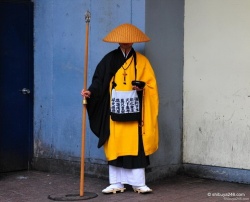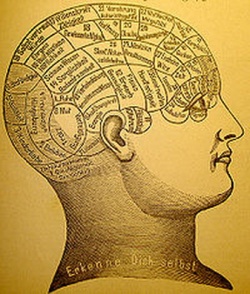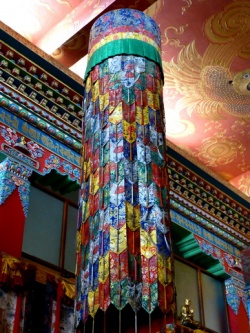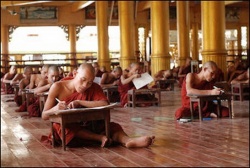Vithi - Process of Consciousness
Glossary
bhavanga-citta = life continuum
atita-bhavanga = past life-continuum
calana-bhavanga = vibrating life-continuum
paccheda-bhavanga = arresting life-continuum
atimahanta-rammana = object of very great intensity
cittakkhana = one conscious-moment
Last week we studied maranasanna nimitta (kamma-related objects at the dying moments). Today we will learn the three types of bhavanga cittas.
Dr. Mehm Tin Mon (1995: p. 140-142) explains: "In the present life the bhavanga cittas take the maranasanna-nimitta of the immediate past life as their object. As this object is not the new external object that appears in one of the sense-doors in the present life that gives rise to a cognitive series of consciousness, we are not aware of it. So when we are asleep or when we do not know anything, these bhavanga-cittas will be arising and dissolving at a tremendous speed of more than a thousand billion (1012) times per eye-wink.
Now suppose that a sense-object appears at one of the sense-doors. It is necessary to know this new object so that we can react to it as the need arises. In order to turn the stream of consciousness towards this new object, the stream of bhavanga-cittas must be arrested or cut off first.
The bhavanga-stream cannot be arrested suddenly as soon as the new sense object appears in one of the sense-doors. As a man, running very fast, cannot stop suddenly at a point and at least a few steps must be allowed before he comes to rest, so also two bhavanga-cittas must pass after the appearance of the sense-object, vibrate somewhat from their normal situtation. So they are known as vibrating life-continuum (bhavanga-calana). But, as the bhavanga-stream is arrested or cut off after the second bhavanga-calana, this citta is renamed as bhavangu-paccheda.
Now the five physical sense-objects do not appear or become distinct at the sense-doors as soon as they are in contact with the sense-door. Even the object of very great intensity (atimahanta-rammana) takes one conscious-moment (cittakkhana) to develop itself into prominence so as to appear at the sense-door.
So one bhavanga-citta must pass from the time of contact of the sense-object with the sense-door to the time of the object appears at the door. This citta is called atita-bhavanga (past life-continuum).
When the sense object is of great intensity (mahanta-rammana), 2 or 3 bhavanga-cittas must pass by from the time of contact of the sense-object with the sense-door to the time the object appears at the door. These 2 or 3 bhavanga-cittas are also called atita-bhavanga.
Thus we have 3 kinds of bhavanga-cittas:
1. Atita-bhavanga = those bhavanga-cittas which pass by from the time the sense-object strikes the sense-door to the time the object appears at the door.
2. Bhavanga-calana = vibrating bhavanga which arises when the sense object appears at the door.
3. Bhavangupaccheda = arresting bhavanga that follows the bhavanga-calana. After this, the bhavanga-stream is cut off and vithi-citta starts arising.
Nina Van Gorkom writes in "Abhidhamma in daily life" (1996):
When a rupa which is one of the sense objects contacts one of the senses, there is first one moment of bhavanga-citta arising and falling away which is denoted by the name atita-bhavanga or "past bhavanga". This citta is succeeded by the bhavanga-calana or "vibrating bhavanga". It is called "vibrating bhavanga" because it is disturbed by the object, although it does not experience that object. The last bhavanga-citta which arises before the stream of bhavanga-cittas is interrupted and the panca-dvaravajjana-citta adverts to the object, is the bhavangupaccheda or "arrest-bhavanga", so called because the bhavanga-cittas process is arrested after this citta.
The different names which denote these bhavanga-cittas do not represent different functions; bhavanga-cittas have as their only function to keep the continuity in the life of a being. The different names only indicate that these bhavanga-cittas are the last ones before the stream is interrupted and a new object which impinges on one of the doorways is experienced by a process of cittas. When the bhavangupaccheda, the arrest-bhavanga, has arisen and fallen away, a sense-door process of cittas which experience an object through one of the sense-doors can begin. When the sense-door process is over, the stream of bhavanga-cittas is resumed, so that the series of cittas succeeding one another in our life is not interrupted. The object which impinged on one of the senses is then experienced through the mind-door. In between the sense-door process and the mind-door process, however, there are bhavanga-cittas. When the cittas of the mind-door process have fallen away, the stream of bhavanga-cittas is resumed.
A sense object which is experienced through one of the five senses is rupa. Rupa arises and falls away, but it does not fall away as rapidly as nama. One rupa which impinges on one of the senses, can be experienced by several cittas succeeding one another in a process. When, for example, the rupa which is sound impinges on the ear sense, it can be experienced by cittas arising in the ear-door process. Before the process starts there are bhavanga-cittas. The last bhavanga-cittas which arise before the sound can be experienced by the cittas of the ear-door process are:
atita-bhavanga (past bhavanga)
bhavanga-calana (vibrating bhavanga)
bhavangupaccheda (arrest-bhavanga)
When the stream of bhavanga-cittas has been arrested, the ear-door-adverting-consciousness (sota-dvaravajjana-citta) adverts to the object through the ear-door. The following cittas in that process which each perform their own function can experience the sound before it falls away.
The Visuddhimagga (XIV, 114) states with regard to the bhavanga-citta:
When the patisandhi-citta has ceased, then, following on whatever kind of rebirth-consciousness it may be, the same kinds, being the result of the same kamma whatever it may be, occur as bhavanga-citta with that same object; and again those some kinds. And as long as there is no other kind of arising of consciousness to interrupt the continuity, they also go on occurring endlessly in periods of dreamless sleep, etc., like the current of a river.
A commentary to the Visuddhimagga, the Paramattha-Manjusa, (478; see Visuddhimagga XIV, 115, footnote 46) explains by way of a simile:
.., But how does there come to be disturbance (movement) of the bhavanga that has a different support? Because it is connected with it. And here the example is this: when grains of sugar are put on the surface of a drum and one of the grains of sugar is tapped, a fly sitting on another grain of sugar moves.
Next week we will study more about vithi (chain of consciousness or cognitive series that arises when a sense object appears at one of the sense-doors in order to be aware of the object).
Bibliography
Buddhaghosa, Bhadantacariya, (no date), "The Visuddhi Magga", translated from the Pali by Bhikkhu Nanamoli, Singapore Buddhist Meditation Centre, Singapore
Dr. Mehm Tin Mon, "The Essence of Buddha Abhidhamma", publisher Mehm Tay Zar Mon, Yangon, 1995
Van Gorkom, Nina (1996) "Abhidhamma in Daily Life", by (Zolag [formerly Triple Gem Press], 3rd Ed., Chapter 12 published online with the permission of the publisher, cited at website
http://www.geocities.com/~madg/gangessangha/Bhavanga.html
also at http://www.vipassana.info/nina-abhi-12.htm, accessed 2 March 2004
Van Gorkom, Nina, "Abhidhamma in daily life", Glossary of Pali terms http://www.saigon.com/~anson/ebud/nina-abhidhamma/nina-abhi-25.htm, accessed 2 March 2004




